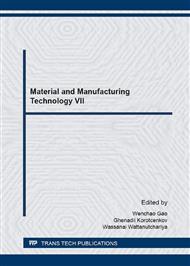[1]
G. Eddy, J. Poinern , N. Ali and D. Fawcett, Progress in Nano-Engineered Anodic Aluminum Oxide Membrane Development, Materials, vol. 4, pp.487-526, Feb. (2011).
DOI: 10.3390/ma4030487
Google Scholar
[2]
G. E. Thompson, et. al., Nucleation and growth of porous anodic films on aluminium, Nature, vol. 272, 433 - 435, Mar. (1978).
Google Scholar
[3]
R. C. Furneaux, W. R. Rigby, and A. P. Davidson, The formation of controlled-porosity membranes from anodically oxidized aluminium, Nature, vol. 337, 147-149, Jan. (1989).
DOI: 10.1038/337147a0
Google Scholar
[4]
M. Aramesh and J. Cervenka, Surface Modification of Porous Anodic Alumina for Medical and Biological Applications, Nanomedicine, pp.439-466.
Google Scholar
[5]
K. Suk Yang, H. Jin Kim, J. Keun Ahn, D. Hyun Kim, Microfluidic chip with porous anodic alumina integrated with PDMS/glass substrate for immuno-diagnosis, Current Applied Physics, vol. 9, pp.60-65, Mar. (2009).
DOI: 10.1016/j.cap.2008.12.031
Google Scholar
[6]
W. J. Stepniowski, M. Noreka, M. Michalska-Domanskaa, A. Bombalskab, A. Nowak-Stepniowskab, M. Kwasnyb and Z. Bojara, Fabrication of anodic aluminum oxide with incorporated chromate ions, Applied Surface Science, vol. 259, pp.324-330, Jul. (2012).
DOI: 10.1016/j.apsusc.2012.07.043
Google Scholar
[7]
C. Ottone, M. Laurenti, K. Bejtka, A. Sanginario and V. Cauda, The Effects of the Film Thickness and Roughness in the Anodization Process of Very Thin Aluminum Films, Journal of Materials Science & Nanotechnology, vol. 1, pp.1-9, Jul. (2014).
Google Scholar
[8]
M. Michalska-Domanskaa, M. Noreka, W. J. Stepniowskia and B. Budnerb, Fabrication of high quality anodic aluminum oxide (AAO) on low purity aluminum - A comparative study with the AAO produced on high purity aluminum, Electrochimica Acta, vol. 105, pp.424-432, Apr. (2013).
DOI: 10.1016/j.electacta.2013.04.160
Google Scholar
[9]
P. Erdogan, B. Yuksel, Y. Birol, Effect of chemical etching on the morphology of anodic aluminum oxides in the two-step anodization process, Applied Surface Science, vol. 258, pp.4544-4550, Jan. (2012).
DOI: 10.1016/j.apsusc.2012.01.025
Google Scholar
[10]
H. Adelkhani, S. Nasoodi, A. H. Jafari, A study of the Morphology and Optical Properties of Electropolished Aluminum in the Vis-IR region, Int. J. Electrochem. Sci., vol. 4, pp.238-246, Feb. (2009).
DOI: 10.1016/s1452-3981(23)15124-8
Google Scholar
[11]
W. J. Stępniowski, and Z. Bojar, Synthesis of anodic aluminum oxide (AAO) at relatively high temperatures. Study of the influence of anodization conditions on the alumina structural features, Surface & Coatings Technology, vol. 206, p.265–272, Jul. (2011).
DOI: 10.1016/j.surfcoat.2011.07.020
Google Scholar
[12]
Kwang Hong Lee, and C. C. Wong, Decoupling two-step anodization in anodic aluminum oxide, Journal of Applied Physics, 106, 104305 (2009).
DOI: 10.1063/1.3257261
Google Scholar
[13]
O. Jessensky, F. Muller, and U. Gosele, Self-organized formation of hexagonal pore arrays in anodic alumina, , Appl. Phys. Lett., Vol. 72, No. 10 (1998).
DOI: 10.1063/1.121004
Google Scholar


